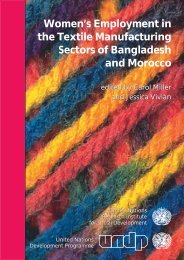Environmental Degradation and Social Integration - United Nations ...
Environmental Degradation and Social Integration - United Nations ...
Environmental Degradation and Social Integration - United Nations ...
Create successful ePaper yourself
Turn your PDF publications into a flip-book with our unique Google optimized e-Paper software.
privatized. However, empirical work has established that communal resource control can be<br />
efficiently maintained, <strong>and</strong> furthermore that it often fulfils an important insurance function by<br />
spreading the risks of poor productivity in a given season across the whole community.<br />
Empirical work has also established that, within social <strong>and</strong> economic structures that encourage l<strong>and</strong><br />
concentration <strong>and</strong> capital accumulation, private l<strong>and</strong> ownership <strong>and</strong> unrestricted l<strong>and</strong> markets can<br />
be very damaging to the environment. This process is particularly obvious in parts of Latin<br />
America, where l<strong>and</strong> accumulation <strong>and</strong> economic policies can create incentives for speculation <strong>and</strong><br />
“throw away” patterns of resource exploitation, in which resources are mined for short-term profit.<br />
Policies that decrease security of tenure for small farmers have also been implicated in<br />
environmental damage. Increasingly large numbers of people alienated from their l<strong>and</strong> often<br />
migrate to areas which may be forested or more ecologically fragile.<br />
<strong>Social</strong> structures determining gender relations also have a significant impact on environmental<br />
change; this relation is discussed in box 4. The role of women in managing natural resources has<br />
increasingly been discussed. Although it would be overgeneralizing to assume that women are<br />
always more protective of the environment than are men, it is evident that gender disparities,<br />
including unequal tenure rights, often aggravate environmental degradation or make environmental<br />
rehabilitation more difficult.<br />
Box 3: Population, Environment <strong>and</strong> Development 11<br />
Recent comparative research involving case studies from Costa Rica, Pakistan <strong>and</strong><br />
Ug<strong>and</strong>a has documented the complexities of the linkages between population,<br />
environment <strong>and</strong> development. The fertility rate in Costa Rica has declined dramatically,<br />
while that of Pakistan has remained static, <strong>and</strong> that of Ug<strong>and</strong>a has risen. Costa Rica’s<br />
demographic transition has been attributed largely to a dynamic economy <strong>and</strong><br />
government efforts to improve education, health <strong>and</strong> sanitation. Demographic policies<br />
have played a secondary role in the process.<br />
High rates of deforestation in Pakistan <strong>and</strong> Ug<strong>and</strong>a would seem to support the common<br />
perception that population pressure exacerbates environmental degradation. However,<br />
Costa Rica’s environmental problems, which include deforestation <strong>and</strong> soil erosion, are<br />
also significant, <strong>and</strong> result not so much from the incremental pressure of population<br />
growth as from large-scale l<strong>and</strong> clearing for pasture <strong>and</strong> export crops. In fact, when<br />
environmental <strong>and</strong> social dynamics are examined at the village level, it becomes clear<br />
that reducing all emerging environmental issues to simple local population growth is<br />
unhelpful. <strong>Environmental</strong> problems develop as a result of the combined impact of many<br />
socio-economic, political, demographic <strong>and</strong> ecological processes. Except in a few<br />
villages studied in Pakistan <strong>and</strong> Ug<strong>and</strong>a where rising population density has had an<br />
exacerbating influence, demographic dynamics have not generally been determinant in<br />
environmental change. Indeed, the Costa Rican case studies have indicated that rapid<br />
environmental degradation such as deforestation <strong>and</strong> soil erosion can occur without<br />
having a high population density. This is also consistent with the findings in Ug<strong>and</strong>a’s<br />
semi-arid Mbarara district, which has one of the lowest levels of population density, but<br />
where current environmental problems include deforestation, pasture degradation <strong>and</strong><br />
soil erosion.<br />
Local communities have made various attempts to accommodate not only environmental<br />
changes but also population levels <strong>and</strong> livelihoods. People have generally been well<br />
informed about the scale <strong>and</strong> the impact of such problems as deforestation <strong>and</strong> soil<br />
erosion in their localities, as well as the need for tree planting, social conservation, forest<br />
protection <strong>and</strong> other environmental rehabilitation initiatives. In certain locations, such as<br />
Costa Rica’s Pacific zone or Pakistan’s northern villages, some positive environmental<br />
initiatives have taken place, promoted by NGOs <strong>and</strong> other external actors. However,
















